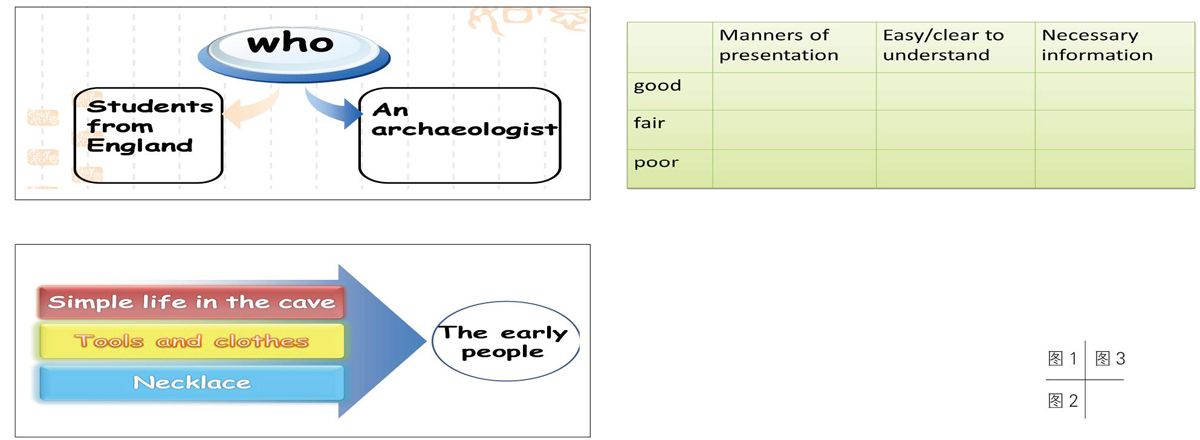冯丽

一、整体设计思路、指导依据说明
《高中英语课程标准》里的三维教学观,具体到英语学科就是要综合发展学生语言知识、语言技能、情感态度、学习策略和文化意识五个方面的素养。而培养学生综合运用语言的能力,实施素质教育的关键环节就是在教学中多进行探究学习、任务型学习、合作学习。
《课程标准》指出:“语言是人类最重要的思维和交流工具”,英语语言教学要“特别注意提高学生用英语进行思维表达的能力”。批判性是思维的重要品质之一,本课指导学生在阅读理解的基础上,对考古学家的工作语言进行理解,培养学生批判性思维的能力,形成自己的见解,并在此基础上进行完整的语言表达。
设计思路:
首先,整合文章,以考古学家为主线,通过对考古学家的工作情况的认识,对考古学家就周口店情况的讲解以及讲解过程中语言特点的分析,让学生站在考古学家的角度来全面、综合运用文章所学知识。
其次,以课文为依据综合训练学生的各项语言技能,培养学生学习策略,提高学生文化意识并形成正确的价值观。
再次,在阅读文本过程中进行问题探究性指导,任务型学习并组织学生进行合作学习。
最后,培养学生批判性思维,在了解全文的基础上,使学生站在考古学家的角度对文章进行主题拓展,即以课文为本,同时又融入学生的个人认识,完成有关周口店的半创作型报告。
二、教学背景分析
教学内容分析:
本单元中心是考古学,语言知识和语言技能都是围绕这一主题设计的。里面涉及到了早期人类的生活状况及细节性的描写,而阅读部分集中在通过考古学家对周口店文化遗址中物品的介绍,使学生了解北京人的早期生活,从而帮助学生增长考古学知识。同时通过对文本的理解使学生在此基础上进行推测,形成对早期人类生活的形象理解。通过阅读使学生理解和使用本单元基础词汇及句式结构,并通过对文中语言的分析,使学生形成自己的见解,从而更好的运用本单元所学知识,并形成良好的价值观,为他们理解古代文明打下良好的基础。
学生情况分析:
学生对考古的知识了解不是太多,而且里面涉及到一些专业术语,所以本单元对于学生来说有一定的难度。但是考古相关的一些东西又使学生们感到好奇,所以在备课过程中教师尽量围绕学生的认知水平展开教学,充分调动学生的好奇心和积极性,激发他们的学习兴趣。同时,通过阅读课文让学生理解考古学家的工作,并站在考古学家的位置上思考问题。
三、教学目标分析
1. Knowledge aims:
Learn and master the new words and expressions about archaeology in this period.
学生理解并认识和考古学及考古学家相关的词汇,为课文阅读及最后输出打下基础;
2. Ability aims:
(1) Use reading strategies (prediction by pictures and titles) to read.
(2) Apply skimming, scanning skills to improve reading ability.
(3) Make a presentation to improve students speaking ability.
学生学会用阅读策略,如通过上下文推理判断、根据图片提示猜测主题,理解文章大意。
在阅读中熟练使用各种阅读技巧,如略读、找读,提高阅读能力。
根据文本内容进行拓展训练,提高说的能力。
3. Emotional aims:
(1) Learn about general idea of archaeologists work and learn some knowledge of the Zhoukoudian Caves.
(2) Develop students moral quality to protect the world cultural heritages.
了解考古学家工作的相关情况,并在考古学家的帮助下熟悉周口店这一文化遗址所折射出的早期人类的生活状况。同时提高学生的道德情感,了解考古学家工作及其发现的重要性并号召人们保护周口店。
四、教学重点、难点分析
教学重点:
1.以考古学家为主线,让学生了解考古学家所发现的周口店的一些具体物品,从而理解早期人类的生活状况;
2.体会考古学家所用语言,分析、理解并使用考古学家的思维进行思考,形成自己的见解。
教学难点:
培养学生批判性思维,让学生掌握分析问题及解释问题的方法,并熟练运用。
五、教学过程设计
步骤1:Warming up (1 min)
Get the students to enjoy some beautiful pictures to the music.
设计意图:以考古发现的文物的精美图片为引,激发学生对考古学的热情。
步骤2:Lead-in (3 mins)
(1) Get the students to know the definition of archeology and the archaeologists work.
Archaeology is a science that studies physical remains found in the ground and people often use scientific analysis to uncover the ancient civilizations.
What do archaeologists usually do? (find some clues from the sentence above)
excavate; collect; analyze
设计意图:让学生发表自己的见解,引起学生对问题的探究,培养了学生观察问题的能力,同时让学生理解并掌握必要的考古词汇。
(2) Give the students some clues for reference and get to the topic of the reading :
Zhoukoudian caves
located in Beijing
famous for the skull
……
设计意图:让学生大胆地开口去说英语,分享他们对周口店的了解。在进行口语表达的同时,培养了学生自主学习的能力,调动他们对即将要学习的知识的好奇心。
步骤3:First-time reading (reading for general idea) ( 3 mins)(见图1)
(1) Go through the text quickly and find out who visited Zhoukoudian caves:
(2) What is the main idea of this reading?
A. The farming and hunting of the earliest people.
B. The introduction of a group of English students to the Zhoukoudian caves.
C. The trade between the earliest people.
D. A brief introduction to the life of the earliest people in the Zhoukoudian caves in China.
(3) What did the archaeologist show to the students?
a needle a necklace and…
Its here that we found evidence of some of the earliest people.
(What does here refer to?) The cave.
设计意图:让学生迅速浏览全文,了解这篇文章的题材特点。通过运用一定的阅读技巧来回答以上问题,把握文章主要脉络。同时锻炼学生通过课文中图片的内容迅速捕捉课文信息的能力,以及通过上下文进行推理判断的能力。
步骤4:Second-time reading(reading for detailed information) (13 mins)
(1) Answer some questions concerning the first part.
① How could they live here?
②How did they keep warm?
③What wild animals were there all that time ago?
Conclusion : the archaeologist explained the simple life of Peking man to students.
(2) Get the main idea of the second part by answering the following questions and put some sentences in right order.
①What does the needle look like?
②How did they make clothes?
Arrange them in the right order:
a. removing the skin
b. rubbing salt onto the skin
c. removing the fat and meat from the skin
d. cutting up animals
e. cutting the skin and sewing the pieces together
答案:d a c b e
Conclusion: the archaeologist focused on the tools and clothes.
(3) Fill in the blanks and answering the question.
Whats the necklace made of ?
Some beads were made of animal ______ but some were made of ______ .
Why was the archaeologist sure that some beads were made of fish bones?
Conclusion : Archaeologist showed something related to the necklace to the students.
Final Conclusion: With the help of archaeologist, the students learned something about the simple life, the tools & clothes and necklace of the early people.(见图2)
设计意图:让学生通过二次阅读课文,完成上述练习,主要是帮助学生获得并理解文章的细节信息。通过对细节问题的理解,使学生在考古学家的帮助下形成对早期人类生活的初步认识,并对考古学家如何得知早期人类生活状况形成初步的认识。学生可以从文中找答案,并通过讨论文本概括大意,充分调动学生的学习积极性,使之成为课堂的主角。
步骤5 :Third-time reading: critical thinking (7 mins)
Can you find some phrases or sentences that the archaeologist used to explain things to the students.
We think it is reasonable to assume…
We have been excavating…
We have been finding…
Our evidence suggests…
It seems…
As the botanical analyses have shown us…
设计意图:第三次阅读文本,让学生体会考古学家语言,分析语篇中的一些重要句式结构。同时运用批判性思维,了解考古学家的工作及其科学性,也为下一部分的使用语言积累素材。在这一部分,学生进行分组阅读,相互探讨,体现出新课程“合作学习”理念。
步骤6 :Producing time (12 mins)
Make a presentation on “Cultural Heritage Day” in order to improve students speaking skills and have a better understanding of the whole text.(见图3)
设计意图: 通过组织学生分组对课文进行重组,以考古学家的口吻为六月份的第二个星期六的“中国遗产日”做有关周口店的口头报告,使学生在对周口店了解的基础上进行扩展性运用,即总体概况——详细介绍——个人看法,目的在于加深对文章内容的理解,同时又锻炼学生的综合语言运用能力,也侧重提高学生说的能力。在这一部分对学生所学知识进行整体评价。
步骤7 : Homework (1 min)
Peking Man site under great threat
The Peking Man site at Zhoukoudian is facing an unprecedented(前所未有的) threat from humans and natural disasters. Experts warned that it might be taken off the World Heritage Site list if no action was taken to protect it.
……
1. Find more information about its current situation.
2. Write a poster to call on people to protect it.
设计意图:学生在学完本节阅读后的扩展阅读,通过考古学家的讲解,学生已经了解到早期的人类生活及周口店的重要地位,但是目前周口店这一文化遗址受到了很多的外来威胁,让学生在已有知识基础上进行课外阅读,同时号召人们要尊重考古学家的发现并保护文化遗址。
六、教学评价设计
评价内容:1、 学生在课上所表现出来的通过阅读策略理解文章的具体情况; 2、学生能否站在考古学家的角度重新审视这篇文章,对材料进行重组,能否全面、清楚的介绍给大家;3、学生是否加强了自身的学习主体意识、小组活动的参与度以及交流的能力。
评价方法:课堂观察评价,师生互评,生生互评,学生自我评价。◎



